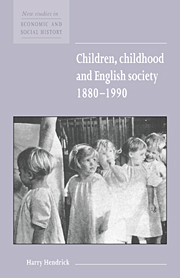Book contents
- Frontmatter
- Contents
- Acknowledgements
- 1 Introduction
- 2 New ideas of childhood: the 1880s to the 1920s
- 3 Parent–child relationships
- 4 Children and social policies
- 5 Children, schooling and the classroom
- 6 Children's leisure
- 7 Conclusion: disappearing childhood and children's rights
- Bibliography
- Index
- Titles available in the New Studies in Economic and Social History series
- Titles available in the Studies in Economic and Social History series
- Economic History Society
7 - Conclusion: disappearing childhood and children's rights
Published online by Cambridge University Press: 05 June 2012
- Frontmatter
- Contents
- Acknowledgements
- 1 Introduction
- 2 New ideas of childhood: the 1880s to the 1920s
- 3 Parent–child relationships
- 4 Children and social policies
- 5 Children, schooling and the classroom
- 6 Children's leisure
- 7 Conclusion: disappearing childhood and children's rights
- Bibliography
- Index
- Titles available in the New Studies in Economic and Social History series
- Titles available in the Studies in Economic and Social History series
- Economic History Society
Summary
In looking at the notions of disappearing childhood and children's rights, which in many respects are contradictory, we see something of the ambivalent attitudes that ‘society’ displays towards children. Nearly all commentators agree that since the end of the Second World War, there have been numerous transformations in the meaning of childhood, and in the experiences of children. Furthermore, many commentators argue that the most profound changes have occurred since the 1960s, a decade that heralded significant developments throughout British social life. The changes affecting children were not all of one kind and certainly did not move in a single direction. There was, and there remains, a constant ebb and flow of liberal and conservative measures and attitudes, which both reflect and influence a variety of age relationships involving children and adults. By way of a conclusion to this book, let us briefly look at two crucial features of these relationships: the proposition that childhood is ‘disappearing’, and the debate about children's rights.
Disappearing childhood
The wide gulf between the substantial minority of children who are economically deprived and the majority who are increasingly affluent troubles many contemporary observers. Others are equally concerned, if not more so, about what they see as the end of innocence (or the ‘fall’ of childhood). Important features of this trend are said to be the ‘sexualization of the world of childhood from the innocence – and ignorance – of the past to the more worldly wise child of today’ [71: 147].
- Type
- Chapter
- Information
- Children, Childhood and English Society, 1880–1990 , pp. 94 - 99Publisher: Cambridge University PressPrint publication year: 1997



